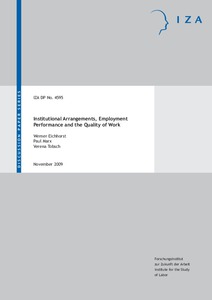Institutional arrangements, employment performance and the quality of work
"The observation of highly regulated, but successful economies has given rise to the hypothesis of various viable models of labor market adaptability. The paper presents a quantitative indicator that tries to avoid a simplified flexibility-rigidity dichotomy and provides a detailed picture of t...
| Main Authors: | , , |
|---|---|
| Institution: | ETUI-European Trade Union Institute |
| Format: | TEXT |
| Language: | English |
| Published: |
Bonn
2009
IZA |
| Subjects: | |
| Online Access: | https://www.labourline.org/KENTIKA-19178226124919964089-institutional-arrangements,-em.htm |
| Summary: | "The observation of highly regulated, but successful economies has given rise to the hypothesis of various viable models of labor market adaptability. The paper presents a quantitative indicator that tries to avoid a simplified flexibility-rigidity dichotomy and provides a detailed picture of the varying institutional configurations by which flexibility is achieved. In order to capture different patterns of flexibility, we differentiate between five types of flexibility which can be combined (external-numerical, internal-numerical, external-functional, Internal-functional, and wage flexibility). Following the dominant analytical perspective in comparative labor market research the indicator is limited to the institutional level (de jure variables). Besides institutional variables influencing external numerical flexibility (employment protection, unemployment benefit system and active labor market policies, taxation and wage setting) we include further institutions which can be assumed to influence adaptability (education, working-time arrangements and firm-specific vocational training)." |
|---|---|
| Physical Description: | 31 p. Digital |

